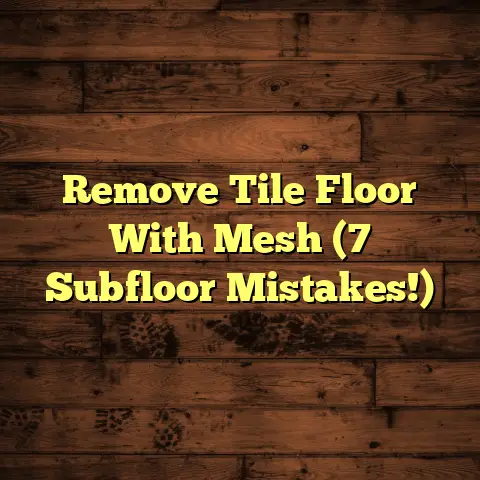How Hard Is Maple Compared To Oak? (Explained)
I always find it fascinating how eco-friendly options are changing the flooring landscape.
With a growing emphasis on sustainability, I often see clients leaning towards hardwoods like maple and oak.
Both are beautiful choices, and they have their unique characteristics.
But which one is harder?
The Hardness of Maple vs. Oak
When I began my journey in flooring, I quickly learned about the Janka hardness test, which measures the resistance of wood to wear and denting.
Maple, specifically hard maple, scores about 1450 on the Janka scale.
In contrast, red oak sits at around 1290, while white oak is a bit harder at about 1360.
You can see right away that hard maple has the edge in terms of hardness.
My first experience with hard maple was in a cozy coffee shop renovation.
The owners wanted something durable to withstand heavy foot traffic.
I remember how surprised I was when I pulled up the sample pieces and felt the density of maple.
It had a smooth finish that felt luxurious under my fingers, and I could already imagine how it would hold up against spills and wear.
Durability in Real Life
In practical terms, what does this hardness mean for everyday use?
In my experience, harder woods like maple resist dings and scratches better than softer options.
For instance, in that coffee shop project, we opted for a hard maple floor.
Over the years, it has held up remarkably well.
Customers shuffle in and out daily, and despite the occasional spill or dropped item, the floor still looks as good as new.
On the other hand, I once installed red oak in a family home.
While it was a stunning choice with its beautiful grain, I noticed that it showed wear more quickly than the maple in the coffee shop.
The family had kids and pets, and within a few years, I could see some scratches that were becoming more noticeable.
Cost Considerations
Cost is another factor to weigh when choosing between maple and oak.
Hard maple typically runs about $5 to $8 per square foot, while red oak can be found for $3 to $7 per square foot.
These prices can vary depending on the region and availability.
I remember using FloorTally to estimate costs for a project where we considered both options.
It helped me input various factors like room size, material choice, and labor costs.
The estimates were spot-on, which made discussions with clients much easier.
Installation Insights
Installation methods also come into play.
Both maple and oak can be nailed down or glued, but due to their density, maple requires more effort during installation.
I’ve encountered situations where flooring nails wouldn’t penetrate as easily into maple without pre-drilling.
This experience taught me to prepare properly and adjust my installation techniques accordingly.
One particular job stands out where I worked with a contractor friend who hadn’t used hard maple before.
He was surprised by how much more effort it took to install compared to oak.
We had to ensure every plank was secure, and I had to remind him that patience is key when working with denser woods.
Maintenance Considerations
Maintenance is also vital to consider.
Both types of wood require similar care—regular sweeping and occasional mopping with a damp cloth are essential.
However, I find that maple tends to show dirt less than oak due to its lighter color and smoother surface.
After a few years of experience with both woods, I’ve developed a routine for maintaining these floors.
For instance, I recommend applying a coat of finish every few years to both oak and maple to keep them looking their best.
However, be cautious: too much finish can lead to a sticky surface that attracts more dirt!
Personal Anecdotes
I recall one memorable project where a client had their heart set on red oak because of its stunning grain patterns.
However, after a few conversations about durability and maintenance, they agreed to try maple instead.
Fast forward a few years later, and they called me to thank me for helping them make that choice; they were thrilled with how well the floor held up against their busy lifestyle.
Another time, I tried to convince a different client about the benefits of hard maple for their kitchen remodel.
They were hesitant at first because they loved the warm tones of oak.
After showing them samples side by side and discussing the long-term benefits of maple’s durability, they finally agreed.
Today, they rave about how lovely their floors look even after years of use.
Aesthetic Appeal
Aesthetically speaking, both maple and oak provide distinct looks that can enhance any space.
Maple has a more uniform texture and lighter color palette, which can brighten up areas and create an airy feel.
It often features subtle grain patterns that lend themselves well to modern designs.
In contrast, oak showcases pronounced grain patterns that add character and warmth to any room.
Red oak has a rich golden hue that appeals to traditionalists, while white oak leans toward a cooler tone with its grayish undertones.
During one project for a farmhouse renovation, the homeowner was torn between the two options based solely on aesthetics.
To help her visualize the final outcome, I suggested creating mock-ups in different lighting conditions.
We placed samples against her existing cabinetry and countertops during different times of the day.
This hands-on approach allowed her to see how each wood interacted with natural light—and ultimately led her to choose white oak for its warm yet sophisticated appearance.
Environmental Impact
As an environmentally conscious contractor, I pay attention to where my materials come from.
Both maple and oak are sourced from North America and are considered sustainable choices if harvested responsibly.
However, it’s essential to check certifications like FSC (Forest Stewardship Council) when selecting wood products to ensure they are sourced from sustainably managed forests.
I once worked with a client who was passionate about eco-friendly choices.
We spent time researching local suppliers that provided sustainably harvested oak and maple options.
It was rewarding to know that we were making decisions that positively impacted both the home’s aesthetic and the environment.
Performance Under Various Conditions
When it comes to performance under varying conditions such as humidity or temperature changes, both woods behave differently due to their cellular structure.
Maple is less porous than oak, making it slightly more resistant to moisture absorption.
During a summer project where humidity levels soared, we installed hard maple in a family’s sunroom that experienced significant temperature fluctuations between day and night.
Surprisingly, we encountered minimal expansion or contraction issues compared to previous jobs where oak was used under similar conditions.
This experience reinforced my understanding of wood behavior in different environments—something I now take into account when advising clients on flooring choices based on their specific climate conditions.
Repairability
Another aspect worth discussing is repairability.
As floors age or endure wear over time, it’s not uncommon for homeowners to seek repairs or refinishing services.
In my experience, both maple and oak can be sanded down and refinished multiple times; however, oak has an advantage here due to its more forgiving grain structure.
There was an instance where I had to refinish a red oak floor after years of family gatherings left their mark on it—scratches from pets’ nails and scuff marks from furniture moved around during parties were evident everywhere!
The sanding process went smoothly as expected; however, when it came time for staining afterward, color consistency proved challenging due to the more pronounced grain variations found in oak compared to maple.
Choosing Between Maple and Oak: Practical Tips
When considering hardwood flooring for your home or business space—whether you lean towards maple or oak—here are some practical tips based on my experiences:
- Assess Your Lifestyle: If you have kids or pets who may cause wear on your floors daily, consider opting for harder woods like maple.
- Consider Aesthetics: Think about your design style—if you prefer lighter tones with subtle grain patterns (maple), or warm hues with prominent textures (oak).
- Evaluate Your Environment: If you live in an area prone to high humidity levels or extreme temperature changes, take note of how each wood type reacts under those conditions.
- Plan for Maintenance: Be prepared for regular maintenance tasks—both wood types require care but could differ slightly depending on your choice.
- Think Long-Term: Consider the longevity of your investment—harder woods may save you money in repairs down the line while still looking beautiful over time.
Final Thoughts
Choosing between maple and oak really comes down to personal preference and specific needs for your space.
If you’re looking for something that can take a beating while still looking gorgeous over time, hard maple is an excellent option.
However, if you prefer traditional aesthetics with a slightly softer feel underfoot, oak might be your pick.
In my experience as a flooring contractor, I appreciate both woods for what they bring to different spaces.
Each has its charm and strengths that can cater to various client needs.
Whether you’re renovating a bustling café or your family home, understanding the differences between these two hardwoods can help you make an informed decision that you’ll enjoy for years to come.
If you have any questions or need advice on your upcoming project, feel free to reach out!





